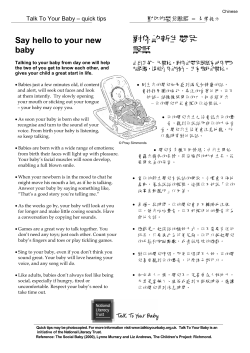
T
Supporting Infants, Toddlers, and Their Families Rocking and Rolling Why Hurry? Respecting Development and Learning Linda Gillespie and Emily Adams T hree-month-old Derrick lies on his back on a blanket. His caregiver, Paola, sits near him and watches him play. Derrick brings his hands toward one another. Sometimes the hands connect and he grasps them, while other times they seem to just be waving near each other. He does this for a few moments while Paola observes, noting this movement and sometimes commenting on the discoveries he is making. She notices when his eyebrows go up, and she imitates that facial expression. When Derrick says “gaa-aaa,” she repeats it back to him. When his hands connect with each other she says, “Oh, you got your hands together! Do you feel that? Both of those hands are yours!” More is better? ® 2, 3 In the first three years of life, infants and toddlers learn and develop at an astonishing rate. What we can see (physical growth, achievement of motor milestones, and children’s ability to talk) is matched by the fast-paced development that occurs in the brain. For example, in the opening vignette Derrick is bringing his hands together. Paola knows this matters—it signifies a milestone in brain development called crossing the midline that is demonstrated by a baby’s ability to reach his hand from one side of his body to the other. This seemingly simple act tells Paola that the two sides of Derrick’s brain are beginning to connect and communicate with each other. This important aspect of brain development will continue and eventually help Derrick to read across the page of a book. The rate of this development depends on Derrick’s genetic makeup as well as the rich interactions and experiences he has now and in the future. There is a lot of pressure on parents and teachers to have children ready for school. Families are inundated with a barrage of information from websites, television commercials, and well-meaning friends about buying or doing certain things so that their children will be successful. Teachers are being pushed to make sure they are instructing children, even babies, in the skills they need to be “ready” for the next step, whether it is preschool or kindergarten or reading. However, David Elkind (1987) states, No authority in the field of child psychology, pediatrics, or child psychiatry advocates the formal instruction, in any domain, of infants and young 98 children. In fact, the weight of solid professional opinion opposes it and advocates providing young children with a rich and stimulating environment that is, at the same time, warm, loving, and supportive of the child’s own learning priorities and pacing. It is within this supportive, nonpressured environment that infants and young children acquire a solid sense of security, positive self-esteem, and a long-term enthusiasm for learning. (8–9) Development is not and should not be a race. Pushing infants and toddlers to learn skills too early takes them away from the very experiences that prepare their brains and bodies to be ready to learn those skills when the developmentally appropriate time comes. With such experiences not only will they learn the skills faster, but they will also be more motivated to learn them because their brains and bodies are ready and able to master these concepts and abilities. Learning takes time. Development unfolds in predictable ways and time frames, but there is great variation among children. Some children say their first word at 8 months while others don’t say words until around 12 or 15 months. Anything within that range is considered to be typical. A baby cannot say words until she is developmentally ready to speak. The muscles in her tongue and face need to be strong enough to shape the words of her language; she needs to hear conversations that expose her to her language or languages; and her brain needs to develop the capacity to understand the meaning of words and the rules of conversation. Development in each area is complex and is dependent on development in other areas. Understanding infant and toddler development is the key to being a competent teacher of infants and toddlers. Knowledge of development shapes teachers’ interactions with children. It influences both the physical and emotional environments they create. So if development isn’t a race, what can we do to make sure babies develop optimally? Slow it down Watch, wait, and wonder are the first three steps toward slowing it down. This approach is about understanding and responding to a baby’s individual development and identifying the rich and varied experiences he needs in order to learn and develop optimally. It respects children’s unique temperaments, personalities, language, culture, and interests: www.naeyc.org/yc n Young Children November 2014 ■■ Watch. Observe which skills babies have mastered and which they are working on. Notice a baby’s interactions with the people and objects around her. What is the baby interested in? What does the baby do to show you what she already knows? ■■ Wait. Intentionally decide when to interact and when to just be present, supporting the baby with your eyes and facial expressions. For example, a baby on his tummy trying to reach a toy might feel frustrated that the object is just out of reach. Rather than hand him the toy, wait for a moment and encourage him with a smile that says, “You can do this.” You might both be surprised that he can, in fact, reach that toy! ■■ Wonder. Ask yourself, what does this mean? What is the baby learning through this interaction? How can the learning in this moment be enriched? ■■ Engage. Play follow the leader, with the baby leading. For example, when a baby says “Da!” you can echo her and say “Da!” This back-and-forth can go on for many turns. Babies love to have opportunities for practicing conversations. ■■ Extend the learning. Offer just enough help, such as describing what you see a child doing, modeling a new way of playing, or adding another prop to help the child discover new challenges to master. These actions keep children engaged and interested just a little bit longer, thus extending their attention span. Gentle interventions like this also help children cope with periods of frustration, which will increase their persistence. In their first three years of life, infants and toddlers learn an astounding amount about their environment, their own abilities, and ways to relate to adults and peers. Infants and toddlers don’t need adults pushing them to learn; rather, young children are naturally eager to seek out experiences and interactions that support their learning. When adults slow down and see the baby as an individual learner with her own goals and ideas, they encourage this motivation. Think about it ■■ How do you believe young children learn? How do you use this information when interacting with infants and toddlers? ■■ Think about a time when you let a baby lead the inter- action. How did that feel to you? How do you think it felt to the baby? ■■ How might you help parents who are feeling pressure to have their baby ready for school understand development and learning? NEW! Technology and Digital Media in the Early Years Tools for Teaching and Learning Chip Donohue, ed. T his is a thought-provoking guide to effective, appropriate, and intentional use of technology with young children. Included are strategies, theoretical frameworks, links to research evidence, descriptions of best practice, and resources to develop essential digital literacy knowledge, skills, and experiences for early childhood educators in the digital age. Copublished with Routledge. This book is a Comprehensive Member Benefit. Item 1123 List $35 Member $28 (20% savings) Order online at www.naeyc.org or call 800-424-2460 option 5 November 2014 Young Children n www.naeyc.org/yc 99 Supporting Infants, Toddlers, and Their Families Rocking and Rolling Coming Soon Try it The next time your impulse is to interact with a child who is already engaged—maybe mouthing a rattle or handling a book—instead, try watching, waiting, and wondering, and then responding. ■■ Play follow the leader, and allow the baby to be the leader. Coaching With Powerful Interactions A Guide for Partnering With Early Childhood Teachers ■■ Learn more about when typical milestones Judy Jablon, Amy Laura Dombro, and Shaun Johnsen ■■ Observe babies to understand what they his interactive, enhanced ebook with embedded video is a guide for coaches and other professionals who support the work of teachers. emerge so that you can help parents understand what to expect at different ages and stages. already know and what skills they are working on, which will help you further promote their development. ■■ Check out these trusted websites for more information on development: ●● www.zerotothree.org ●● http://developingchild.harvard.edu T Item E002 List $60 Member $48 (20% savings) Order online at www.naeyc.org or call 800-424-2460 option 5 A final thought from Elkind (2007): “Hurrying children into adulthood violates the sanctity of life by giving one period priority over another. But if we really value human life, we will value each period equally and give unto each stage of life what is appropriate to that stage” (221). References Elkind, D. 1987. Miseducation: Preschoolers at Risk. New York: Knopf. Elkind, D. 2007. The Hurried Child: Growing Up Too Fast Too Soon. 25th ann. ed. Cambridge, MA: Da Capo. NAEYC thanks these Year-Round Sponsors for their generous support. year-round platinum Linda Gillespie, MS, of ZERO TO THREE, has worked in the field of early childhood with a specific focus on infants and toddlers for the past 40 years. lgillespie@zerotothree.org year-round gold Emily Adams, MA, is a senior writing and training specialist at ZERO TO THREE. She has spent her career in Early Head Start working with infants, toddlers, and their families and supporting teachers and home visitors. eadams@zerotothree.org Rocking & Rolling is written by infant and toddler specialists and contributed by ZERO TO THREE, a nonprofit organization working to promote the health and development of infants and toddlers by translating research and knowledge into a range of practical tools and resources for use by the adults who influence the lives of young children. Rocking and Rolling columns are available at www.naeyc. org/yc/columns. For more information on the NAEYC Sponsorship Program, please visit www.naeyc.org/content/sponsorships. Copyright © 2014 by the National Association for the Education of Young Children—1313 L Street NW, Suite 500, Washington, DC 20005. See Permissions and Reprints online at www.naeyc.org/yc/permissions. 100 www.naeyc.org/yc n Young Children November 2014
© Copyright 2025
















